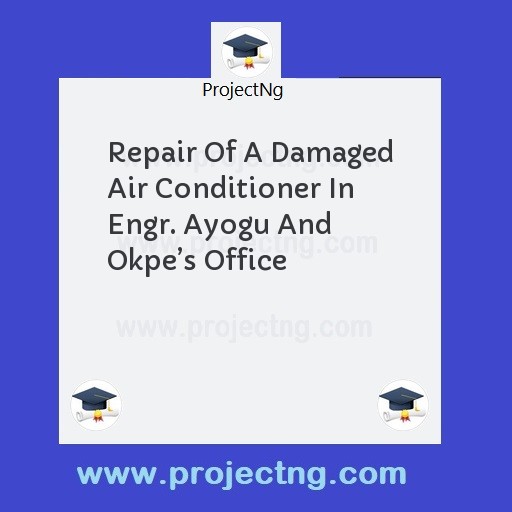Repair Of A Damaged Air Conditioner In Engr. Ayogu And Okpe’s Office
Accounting Project Topics
Get the Complete Project Materials Now! »
REPAIR OF A DAMAGED AIR CONDITIONER IN ENGR. AYOGU AND OKPE’S OFFICE
ABSTRACT
This project is basically on the repair of a damaged air conditioner. It is intended to provide a break through in the restoration of any damaged air conditioner and thereby curtail the huge expenses incurred in the replacement of the entire unit.
This report covers an introduction into what an air conditioner is all about, it’s historical background and working principle. A view on the installation techniques and the maintenance application are also contained in this report. The actual repairs undertaken were analysed and the economic cost of the repairs were equally specified.
After the repairs and changing of some damaged components, the system was tested and found to be functional again thereby satisfying the objective of the project.
TABLE OF CONTENTS
Title page
Letter of transmittal
Release page
Approval page
Dedication
Acknowledgement
Abstract
Table of contents
CHAPTER ONE
1.0 Introduction
1.1 Air Conditioner
1.2 Historical Background
CHAPTER TWO
2.0 Literature Review
2.1 Air Conditioning System
2.2 Working Principle of Air Conditioner
2.3 Window Unit/Through Wall Air Conditioner
CHAPTER THREE
3.0 Analysis of Operation
3.1 Specification of Air Conditioner
3.2 Troubleshooting
3.3 Repair of The Faulty Air Conditioner
3.4 Installation of The Repaired Air Conditioner
CHAPTER FOUR
4.0 Cost Analysis
CHAPTER FIVE
5.0 Recommendation
5.1 Conclusion
References
CHAPTER ONE
1.0 INTRODUCTION
1.1 AIR CONDITIONER
An air conditioner system is an assembly of various components which operate in a controlled manner to produce a specified condition of the air within a space or building.
To produce complete air conditioning, a system must heat, humidify, cool, dehumidify ventilate, filter and circulate air within the conditioned space all for the comfort of the user.
Air conditioner has a wide range of capacities for rooms of various sizes. It has been common to rate units in tons but a better method is by BTU (British Thermal Unit). A small capacity air conditioner may be 5500 BTU and a larger one 15,000 BTU. It can also be rated by horse power, which describes the power needed to drive electric component and not cooling capacity. The capacity required is determined by size of space to be cooled, the building installation, direction of window to sun or shade, heat source in the room (from a gadget0 and the normal occupancy.
The electric voltage required is normally between 115 – 230 volts.
1.2 HISTORICAL BACKGROUND
The roots of air conditioning as we know today, are in refrigeration. T he elements of an air conditioning system were well known before the first complete system was built in 1902. Before now, fans and refrigeration had been invented, ice had been used for cooling for centuries and there had been duct work for central heating.
The first systematized approach to control indoor atmosphere was made by Willis Carrier, a 25 year old engineer for a Buffals N.Y. heating firm. The problem was that hot humid summer air was causing faulty reproduction of four colour illustrations for a litographic form in Brooklyn. N.Y. Carriers machine combined cooling and humidity control for summer and heating and humidifying for winter. He used fans to blow the hot humid air over coils of cold water piped from ammonia frigeration machine. He worked out the proper amount of cold coil surface needed and required temperature and air conditioning.
In 1906 Stawart Grammer applied it in 1911 Carriers’ rational psychometric formula, set forth the data necessary to design relationship between moisture content and temperature, and enabled engineers to calculate the requirement for air conditioner. The development of lightweight formed coiling coils made possible a more effective heat transfer surface from the warm air to the refrigerating coils. Gas refrigerants were considered dangerous for small installation until the first toxic refrigerant, feron was invented. It made possible installation of home air conditioning units and room air conditioner.
Be the First to Share On Social

Enjoying our content?
Don't miss out on new videos! Subscribe to our YouTube channel for more awesome content.
Subscribe Now!













